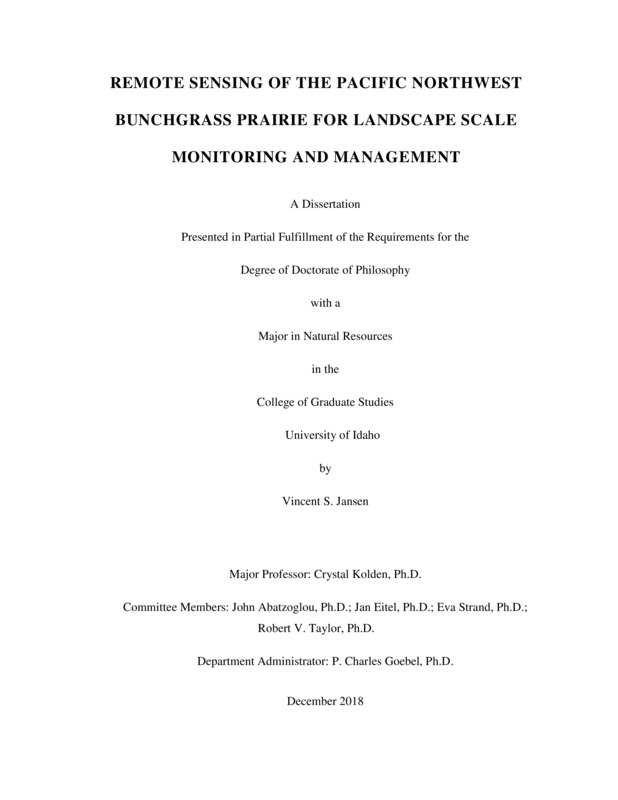REMOTE SENSING OF THE PACIFIC NORTHWEST BUNCHGRASS PRAIRIE FOR LANDSCAPE SCALE MONITORING AND MANAGEMENT
Jansen, Vincent S.. (2018-12). REMOTE SENSING OF THE PACIFIC NORTHWEST BUNCHGRASS PRAIRIE FOR LANDSCAPE SCALE MONITORING AND MANAGEMENT. Theses and Dissertations Collection, University of Idaho Library Digital Collections. https://www.lib.uidaho.edu/digital/etd/items/jansen_idaho_0089e_11482.html
- Title:
- REMOTE SENSING OF THE PACIFIC NORTHWEST BUNCHGRASS PRAIRIE FOR LANDSCAPE SCALE MONITORING AND MANAGEMENT
- Author:
- Jansen, Vincent S.
- Date:
- 2018-12
- Embargo Remove Date:
- 2021-07-08
- Keywords:
- Grassland Landsat Lidar Rangeland Monitoring Rangelands Remote Sensing
- Program:
- Natural Resources
- Subject Category:
- Geography; Remote sensing; Range management
- Abstract:
-
Temperate grassland ecosystems are an at-risk biome type due to large amounts of conversion to other land use types as well as the mismanagement of livestock grazing. Livestock grazing is the largest land use type across the globe and can have both positive and negative feedbacks on ecosystem. Increasingly researchers and managers are wanting information regarding habitat heterogeneity due to its links to biodiversity. Monitoring meaningful grassland ecosystem indicators, as well as vegetation pattern at relevant management scales, and how they respond to management and environmental drivers has proven difficult with small plot scale research projects as well as in-field point based monitoring. Remote sensing technologies provide a different way to quantify grassland landscapes at various scales and can provide information on important and needed ecological patterns and management relevant grassland attributes such as biomass.
In this dissertation I build upon the previous remote sensing science, by developing an algorithm that returns estimates of vegetation cover and biomass, driven by sensor and vegetation greenness using the Landsat surface reflectance products. These algorithms were significantly correlated to vegetation cover and biomass (R2 > 0.70) across varying phenological states enabling them to be used to monitor and analyze vegetation amounts across the grazing season for adaptive management.
Next, I tested the ability of airborne lidar to provide estimates of grassland biomass at the landscape scale. In, finding that airborne lidar can in fact model grassland biomass (pseudo R2 =0.59; RMSD =139.4 g m-2) I then aggregate this biomass data to coarser cell sizes and compute geo-statistics on each of the resulting resolutions to determine the effect grazing has on vegetation heterogeneity at various spatial scales. Results showed that statistically different measures of heterogeneity were produced from the variogram models using the biomass estimates from the varying grid cell sizes. When relating the pasture level variogram statistics to stocking rate across the 23 pasture areas, we observed that the range statistic (a proxy for patch size) was only variogram metric sensitive to grazing and this was only significant across the 1m through 8m cell sizes tested. This research successfully quantifies spatial heterogeneity and finds that within the Zumwalt Prairie (a section of the Pacific Northwest Bunchgrass Prairie), grazing at low to moderate rates decreases spatial heterogeneity of vegetation amount.
Lastly, I test the relationships between the Landsat-derived biomass algorithm tuned for the Pacific Northwest bunchgrass prairie with short term monitoring data on stocking rate and end of year utilization. In this study we find significant but weak to moderate correlations between the short-term monitoring indicators at both the pasture and plot scales and the biomass metrics including end of year residual biomass, and the relative difference in biomass between summer and fall. While the correlations were moderate to week, the ability to track pasture averages, and map across the study area biologically relevant thresholds of vegetation amount and change in vegetation between summer and fall provide a new way for land managers and rancher to monitor their management actions across the landscape. In this chapter I attempt to move beyond the statistics of modeling of vegetation amounts with remotely sensed data and demonstrated how remotely sensed vegetation data can directly inform adaptive management.
- Description:
- doctoral, Ph.D., Natural Resources -- University of Idaho - College of Graduate Studies, 2018-12
- Major Professor:
- Kolden, Crystal A
- Committee:
- Abatzoglou, John; Eitel, Jan; Strand, Eva; Taylor, Robert V.
- Defense Date:
- 2018-12
- Identifier:
- Jansen_idaho_0089E_11482
- Type:
- Text
- Format Original:
- Format:
- application/pdf
- Rights:
- In Copyright - Educational Use Permitted. For more information, please contact University of Idaho Library Special Collections and Archives Department at libspec@uidaho.edu.
- Standardized Rights:
- http://rightsstatements.org/vocab/InC-EDU/1.0/

